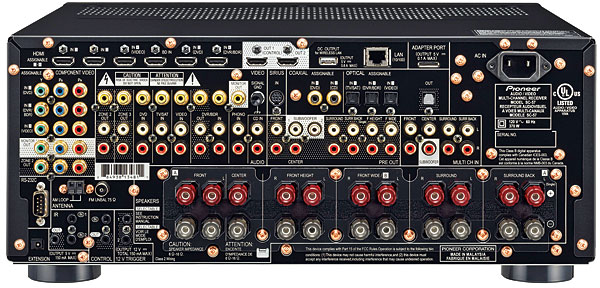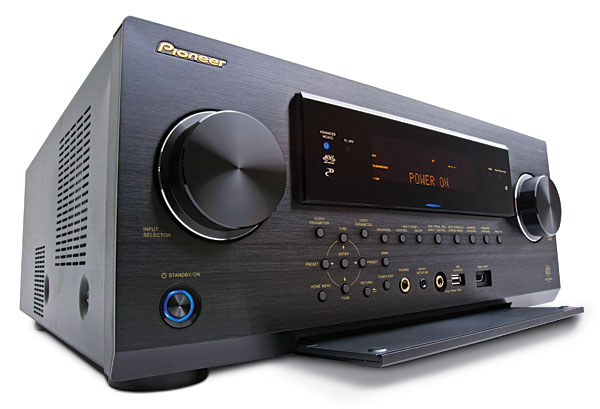Pioneer Elite SC-57 A/V Receiver Page 2
The Home Media Gallery also supports DLNA network devices if you do Windows. I don’t, but it supports up to 192-kHz/24-bit FLAC file streaming, which Mac does not.
On the video side, the Pioneer incorporates Marvell’s highly regarded Qdeo video processor, while the room correction software and setup is Pioneer’s proprietary MCACC. Like most setup/room correction schemes, MCACC uses a supplied microphone and test tones to automatically calculate speaker size and location. It also corrects for a variety of room and speaker issues. MCACC graphs each parameter’s changes, and you can make manual adjustments afterward in the GUI.
Download the instruction manual from Pioneer’s Website, and you’ll see that this AVR offers even more features and functionality that space won’t let me describe. It’s really chock full.
A Smart Smartphone App
Pioneer’s phone app for iPhone and Android (also available for iPad) is both functional and video-game-like. Describing it completely would also take up more space than we have, but basically you can: adjust volume by spinning a large, blue LEDringed virtual dial, select input, choose at the push of the touchscreen any of the mind-numbing listening mode choices, and monitor and adjust video processing modes. That means you can use your phone’s touchscreen to see the effects of switching a plethora of video processing features on and off in real time—instead of having to first lose the picture to access the GUI.
And that’s the functionality in but one of four sectors available through the app. In the Emphasis sector, you can choose Dialogue, Bass, or Finger EQ. When you tilt the phone, you can increase or decrease the prominence and dynamics of the dialogue channel or the output of the subwoofer. In the Finger EQ feature, you can adjust a nine-band EQ curve with your finger and save it (along with others you create) to memory for instant recall. Another sector called Balance lets you move within a circle, a virtual bubble level that can change the front/back and left/right balance. Trust me, you’ll love this app.
Setup and Use
Unfortunately, Pioneer’s instruction manual for this AVR, like that for so many other receivers out there, is unsatisfactory. Diagrams are small, and the writing is filled with clumsy passive-tense construction that’s sometimes difficult if not impossible to decipher. Download the manual and read for yourself. If you do, check page 32, section 3 of the Full Auto MCACC room correction feature (“Select the parameters you want to set”), and tell me what it means.
Pioneer includes an innovative interactive AVNavigator CDROM that guides you through the wiring and connection the first time you use it. You can also use this to perform setup from a network-connected computer, and it can act as the remote control. The software is Windows only, though an iPad version is said to be on the way.
I like to first try setting up an A/V receiver or surround processor without using the instructions to see how intuitive it is. For instance, I could fully set up and operate the Marantz AV7005 (Home Theater, April 2011) without the manual. That wasn’t possible here—and not because of the Pioneer’s enhanced functionality and feature set.
The GUI and the back-panel layout are neither as user friendly nor as intuitive as those that some other brands offer. For example, the inputs aren’t numbered in the GUI and are strangely ordered on the back panel. HDMI inputs 1 and 2 are on the back panel, but 3 is on the front. The one adjacent to 2 on the back panel is 4. The subsequent ones are pre-assigned and named for BD, DVD, DVR, etc. Most products put the pre-assigned inputs first, which makes more sense to me.

I also found other aspects of the GUI less than intuitive, but space won’t permit me to further elucidate. Just consider this fair warning that, even if you know what you’re doing, you might find yourself plodding through the initial setup.
Those issues aside, once you’ve figured out the system and have gotten everything configured, using the SC-57—particularly with the smartphone app—is relatively enjoyable. As with many other AVRs, the main programmable backlit remote contains too many small, similarly sized buttons. However, once you’ve tried the phone app, you’ll be on to that anyway.
Three more small nit-picks: While the front-panel display is generously sized, the graphics are too small to be of any use unless you’re seated close to the display. Pioneer also seemingly saved some money by not recessing the controls that are behind the front-panel door. I found that if you close the door too forcefully, you can accidentally change inputs or other parameters. Finally, while the iPod function worked flawlessly through the USB port, the port wouldn’t play a USB stick with FLAC and MP3 files of the entire Beatles catalog, despite it working fine in the Marantz AV7005. FLAC is among the SC-57’s supported files, but it didn’t work with these, and the unit showed the stick as empty.
Warm, Coherent Sound
Whether I ran it through the MCACC setup routine or not, the SC-57 produced noticeably warm, rich, coherent sound that was very well controlled on both top and bottom. An experienced listener might note an exceptionally well-damped, tight bottom end and a dry, less than fully extended and airy top end—and perhaps figure out pretty quickly that this isn’t Class A/B amplification. But even a hardened audiofool like me came away from a few weeks spent with the SC-57 very impressed and enthused about the future of Class D in this application. Still, in a vinyl-based two-channel system, I’ll still stick with Class A/B and Class A, thank you. (Speaking of vinyl, the moving-magnet input was also surprisingly good.)
 To summarize, the Class D sound here definitely differs from what I’d expect from a good Class A/B amplifier, particularly in terms of air, extension, liquidity, and especially decay length. But the differing characteristics produced great clarity and solidity, and the leading edge of transients were free of undesirable etch and hardness that have plagued some other Class D designs. Stage coherence, whether in stereo or surround, was among the best I’ve heard from any AVR at any price, and instrumental body and weight were positively meaty.
To summarize, the Class D sound here definitely differs from what I’d expect from a good Class A/B amplifier, particularly in terms of air, extension, liquidity, and especially decay length. But the differing characteristics produced great clarity and solidity, and the leading edge of transients were free of undesirable etch and hardness that have plagued some other Class D designs. Stage coherence, whether in stereo or surround, was among the best I’ve heard from any AVR at any price, and instrumental body and weight were positively meaty.
To give you some idea, an audiophile friend came over during my audition. While I played a three-track RCA Living Stereo reissue on SACD, he stood waiting on the landing a half level below the living room, where he couldn’t even see the speakers. “Wow, that piano has such body!” he exclaimed, which is exactly what I’d been saying to myself a few minutes before he arrived. Imaging was unusually precise, both in stereo and surround mixes, perhaps giving credence to claims of the SC-57’s emphasis on maintaining phase coherence. This was clearly evident on two-channel and surround sound music or movies.
The surround Dark Side of the Moon SACD was noticeably darker than I’ve become accustomed to. The bells sounded more burnished and richer than before, and the coin sound effect was also less clangy. But the quality of the transient attack rang true and didn’t sound at all softened.
In some ways, the combination of the amps and the MCACC room correction produced the most coherent and pleasing sound I’ve yet heard from my Sonics by Joachim Gerhard speaker system. The bit of metallic overlay I’m used to hearing was replaced by a velvety, warm character.
The sound was drier, darker, and less airy than I’m accustomed to with my reference system. There was also less of what I’d call mechanical artifacts that I sometimes hear with my speakers, which use metal-cone drivers. I don’t believe that metal-coned and -domed drivers sound metallic, or that paper ones sound papery, or that ceramic ones sound like Corningware. Still, my speakers, good as they are, do exhibit a slight leading-edge artifact that sounds metallic. Whatever the cause, the SC-57’s setup software and/or amp characteristics tamed it to a remarkable degree. Along with producing smoother overall sound, this helped to create a coherent soundstage across the front of the room that completely hid the location of the three speakers and left no holes between them.
The effect on the center-channel speaker was transformative. Regardless of the quality of the incoming signal (Dolby Digital, DTS, Dolby TrueHD, DTS-HD Master Audio, etc.), voices sounded more realistic through this system than through any other, including my reference, which includes a Parasound Halo A 51 five-channel amplifier that costs more than twice the price of the SC-57 alone. Chest, throat, and mouth were in perfect balance, although I suspect this was at the cost of some air and upper-frequency detail in the recording.

I watched Jonathan Demme’s masterful and talky Rachel Getting Married (recommended). Despite its rapidity, the dialogue was remarkably well articulated and easy to understand. During the few parts where it was less than fully understandable, I angled my smartphone. This subtly brought the center channel forward in the mix with both increased volume and dynamics. A button-push returned it to normal. When musical guest Robyn Hitchcock sang, his voice sounded noticeably natural, clear, three-dimensional, and free of glaze.
I couldn’t fault the bass performance, either. Extension was full, combined with well-damped and controlled bass transients and rhythmic dexterity. The MCACC’s subwoofer setup was the best I’ve heard from any automatic software. I couldn’t have dialed it in better myself. I’ll take the SC-57’s somewhat airless and less-than-exuberant top-end performance anytime over some of the bright- and thin-sounding electronics I’ve heard in recent years.
Conclusion
If you can get past the less than user-friendly GUI and instruction manual and the unintuitive first-time setup and make it a point to tap the smartphone app, you’ll find that using the SC-57 is a pleasure. And while Pioneer’s MCACC setup and room correction software may have an ungainly name, its effectiveness is impressive, even transformative.
This AVR’s nine-channel, three-zone capabilities (including HD component video available to Zone 2) offer unparalleled setup flexibility. If your speakers can be biamped, I’d bet the sonic improvement would be noticeable. The system’s somewhat dark character will work better with speakers that are either bright or relatively flat on top and less well with already dark speakers that tend roll off the highs. But whatever your speakers’ tonal character, there should be more than sufficient power to drive them to their full dynamic potential.
As an old stalwart, I still prefer a good Class A/B amp. But the Pioneer Elite SC-57’s Class D amp is so good that in some ways it’s more a matter of different than better or worse. I can understand why some might prefer its sonic character. In the end, the SC-57 offers a lot of everything—including great sound—at a very reasonable price.





























































